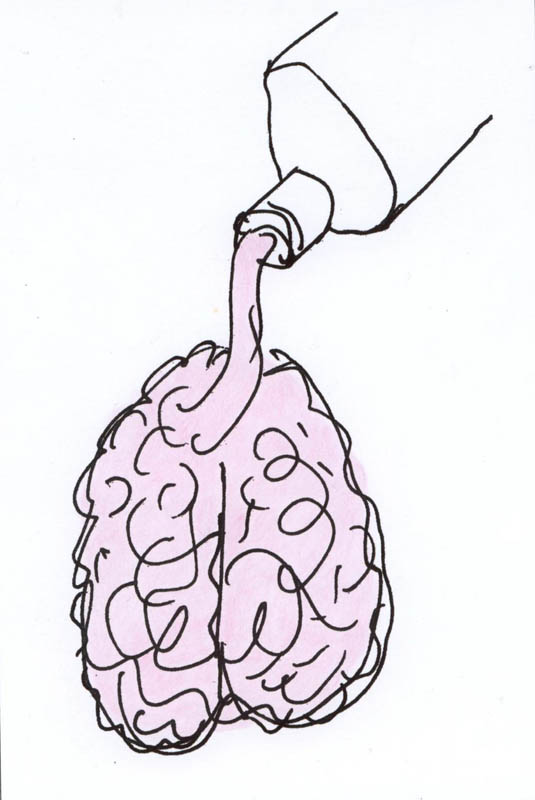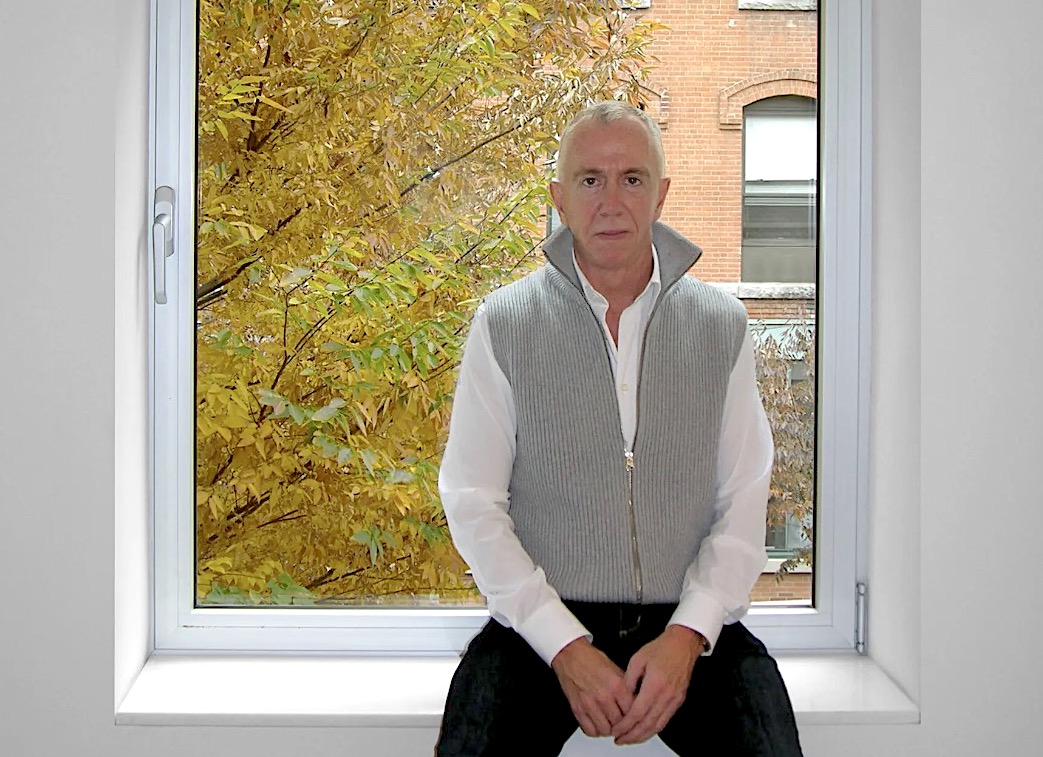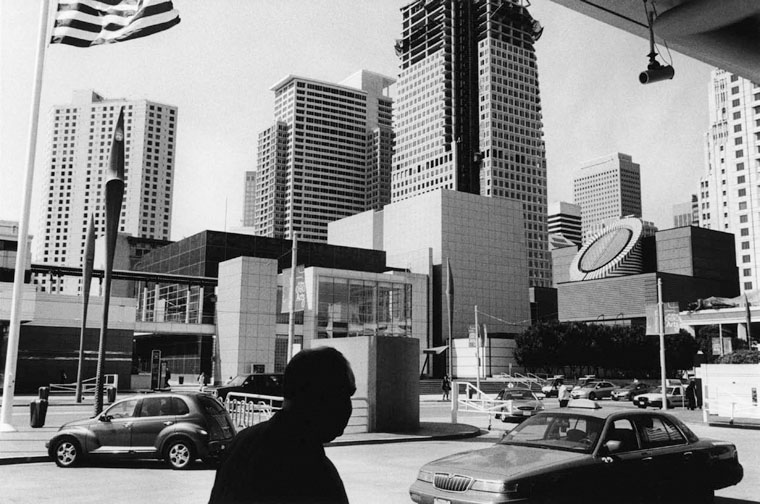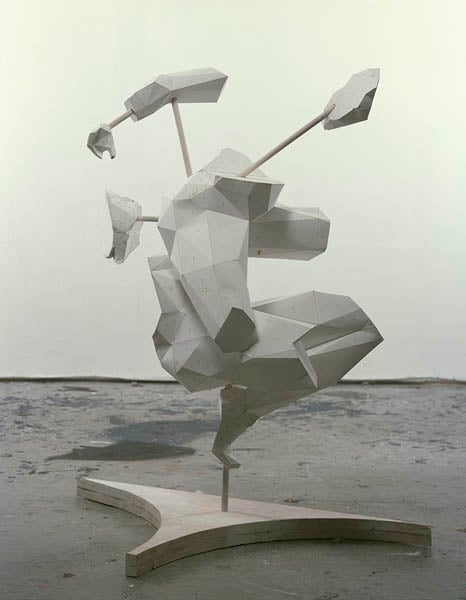
© » KADIST
Alexandre da Cunha
His Deck Painting I recalls the simplistic stripes of conceptual artist Daniel Buren, or the minimal lines of twentieth century abstract painting, but is in reality a readymade, fashioned from repurposed fabric of deck chairs. Alexandre da Cunha reinvents found objects in surprising ways that combine the material characteristics of Arte Povera with the concerns and techniques of painting. Da Cunha’s work often features flags—either as a found material per se or as a constructed form—that reflect the artist’s interest in issues of nationality, governmental politics, allegiance, and culture.

© » KADIST
Mario Garcia Torres
Mario Garcia Torres films a game of Charades among professional actors guessing the former North Korean dictator’s favorite Hollywood films. Indeed rather surprisingly Kim seems to have had a huge collection of Western videos and he published a book called “On the art of the Cinema” in 1973. As the final acknowledgments indicate, Garcia Torres’s work was produced following in depth research, consulting information given by director Shin Sang-ok who has been kidnapped by Kim in 1978, as well as Jerrold Post (The George Washington University) and Timothy Savage (Nautilus Institute for Security and Sustainable Development).

© » KADIST
Pablo Pijnappel
In Felicitas, we follow the converging routes of three characters: Felicitas, Michael and Andrew (the artist’s father-in-law who also features elsewhere). Felicitas is thedaughter of a German industrialist who immigrated to Rio after the Second World War. She is the one visible with a toucan in several images.

© » KADIST
Juan Capistran
White Minority , is typical of Capistran’s sampling of high art genres and living subcultures in which the artist subsumes an object’s high art pedigree within a vernacular art form. Here, Capistran humorously remixes the form and style of Frank Stella’s Black Paintings with California punk rock band Black Flag’s song title and logo (created by artist Raymond Pettibon). White Minority , then, appropriates, recontextualizes, and riffs on language and visual signs to unmoor notions of identity, power, and revolution.

© » KADIST
Jennifer Locke
Choke documents the artist filming a wrestler “choking out” his teammate until he is unconscious. This closed circuit of dominance and submission between two powerful men, is echoed by the closed circuit of the video through which the viewer takes on the role of voyeur. The artist’s presence in the piece not only calls attention to its staging, but inverts the traditional power dynamic of the “male gaze” and gender roles.

© » KADIST
Gregory Crewdson
Forest Gathering N.2 is part of the series of photographs Beneath the Roses (2003-2005) where anonymous townscapes, forest clearings and broad, desolate streets are revealed as sites of mystery and wonder; similarly, ostensibly banal interiors become the staging grounds for strange human scenarios. These scenes are tangibly atmospheric, visually alluring and often deeply disquieting. Never anchored precisely in time or place, these and the other narratives of Beneath the Roses are rather located in the dystopic landscape of the anxious American imagination.

© » KADIST
Emma Wolukau-Wanambwa
A short video about Tate Modern by Emma Wolukau-Wanambwa depicts just two shots, both featuring the artist. The first scene portrays Wolukau-Wanambwa in a close-up frontal view, dressed in black, standing silently against a worn white wall. Through subtitles, the artist recounts her experience of participating in a workshop on the top floor of the museum.

© » KADIST
Raymond Pettibon
The five works included in the Kadist Collection are representative of Pettibon’s complex drawings which are much more narrative than comics or cartoon. The images allude to recurring topics, such as the superhero (present both in Untitled Superman and No title without the comics ), a book cover (his literary sources), or a mushroom cloud. Inspired by the writings of William Faulkner, Daniel Defoe, Gustave Flaubert, Marcel Proust, and James Joyce, Pettibon’s sophisticated, witty drawings combine image and text to explore the gamut of American popular culture.
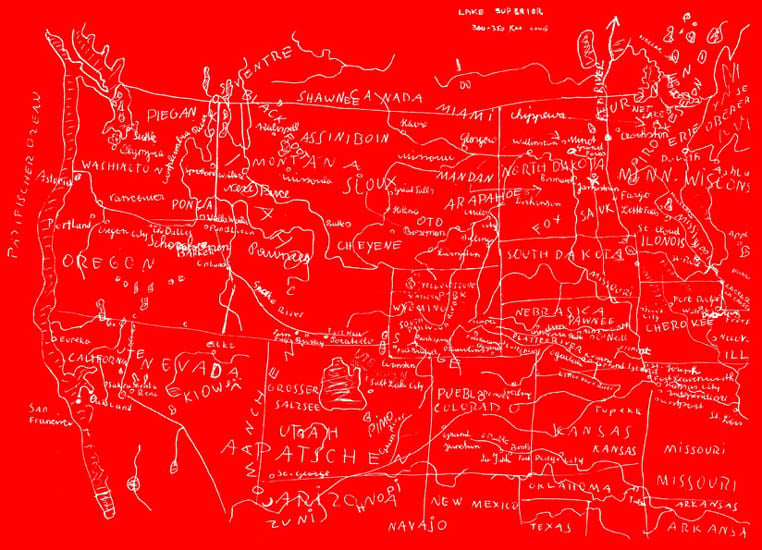
© » KADIST
Peter Friedl
Drawing & Print (Drawing & Print)
Map 1969-2005, a poster glued on the wall, questions space in its relation to geography. On a red background, a free-hand drawing in white refers to the aesthetics of maps. Map 1969-2005 is not an accurate map of the United States, but one that combines mapping, overlaps and merges diverse elements: Oregon, Lake Superior, San Francisco, Cheyenne, Missouri, Zuni, Navajo, Texas, Shawee, Colorado, Piegan, Canada, Miami, etc.

© » KADIST
Shooshie Sulaiman
Drawing & Print (Drawing & Print)
Shooshie Sulaiman’s pictures of unidentified figures initially appear alien and even monstrous: rendered hairless in unusual and even sickly colors, they stand in stark contrast to the aesthetic ideals of conventional portraiture. The subject in Dulu atas pedestal, sekarang dalampedestal / Before on pedestal, now inside (2005), a ball point pen and charcoal rendering of a bald figure with a wide-eyed stare, appears caught in a distressingly static state, at once both uncomfortable and yet incapable of ameliorating his condition. Sulaiman’s subject here becomes an almost frightening sight, the emotive brush strokes replaced by the ball point pen’s erratic black lines, the eyes and mouth scribbled over in a deliberately defacing gesture.

© » KADIST
Raymond Pettibon
The five works included in the Kadist Collection are representative of Pettibon’s complex drawings which are much more narrative than comics or cartoon. The images allude to recurring topics, such as the superhero (present both in Untitled Superman and No title without the comics ), a book cover (his literary sources), or a mushroom cloud. Inspired by the writings of William Faulkner, Daniel Defoe, Gustave Flaubert, Marcel Proust, and James Joyce, Pettibon’s sophisticated, witty drawings combine image and text to explore the gamut of American popular culture.

© » KADIST
Michal Chelbin
Michal Chelbin’s staged yet intimate portrait photographs, seduce the viewer into uncomfortable, voyeuristic complicity with the camera. Several works represent adolescent girls on the verge of sexual consciousness, their bodies still that of a child while their gaze directly confronts the viewer implying differently. Michal Chelbin shoots in a format of utter stability-the square.

© » KADIST
Saâdane Afif
In this work, Saâdane Afif quotes André Cadere’s round wooden batons using the copy share and remix principles. Cadere’s sculptures, batons constituted with a mathematical chain of painted wood segments containing one error in the succession of colors, can be presented according to any possible configuration (on the wall, floor, hung or not). In the catalogue documenting the project, Power chords, there is a facsimile (another type of quotation) of one of Cadere’s conferences: “Présentation d’un travail, utilisation d’un travail” (presentation of a work, use of a work).

© » KADIST
Alexandre da Cunha
Glaze (Savana) (2005) is an assemblage of found materials: a car wheel, a tire, and a wooden plinth of the type traditionally used to display sculpture. It directly engages with the readymade, a subject that Alexandre de Cunha takes up throughout his practice, often inflecting it with a tropical, and South American–inspired materiality and painterly style that could potentially come across as a stereotype. Here, da Cunha transforms the component parts into a composition that highlights often-overlooked materials of artistic production and cultural mass-production.

© » KADIST
Todd Hido
The two pieces in the Kadist Collection depict foggy landscapes, one at dawn, the other at nighttime. Both dimly lit scenes are dominated by an eerie feeling. Taken by a road, these painterly photographs suggest the uncanny character of the transient.

© » KADIST
Chloe Piene
Drawing & Print (Drawing & Print)
The figure in Armless tapers away. Muscular legs turned upright spin down into a disintegrating torso. Lines, that in another drawing would sketch out contours and volume, here seem to be strands of flesh.

© » KADIST
Shooshie Sulaiman
Shooshie Sulaiman’s pictures of unidentified figures initially appear alien and even monstrous: rendered hairless in unusual and even sickly colors, they stand in stark contrast to the aesthetic ideals of conventional portraiture. The green acrylic paint used for the subject’s skin in Maka Panau / Tinea Vesicolor (2005), for example, evokes cultural associations between phenotype and diseases such as hypochromic anemia, a blood-related illness historically diagnosed by the green-hued tone it produced in a patient’s pallor. Staring at the viewer a forlorn gaze, Sulaiman’s subject appears caught in a distressingly static state, at once both uncomfortable and yet incapable of ameliorating his condition.

© » KADIST
Carlos Amorales
Drawing & Print (Drawing & Print)
Produced on the occasion of an exhibition at ARTIUM of Alava, Basque Centre-Museum of Contemporary Art, this deck of cards is a selection of images from Carlos Amorales’s Liquid Archive. and abstract silhouetted motifs, in a black and white palette, are combined to create a world lodged between fantasy and reality typical of the tarot game. Airplanes, letters, naked women, Osama Bin Laden, Che Guevara, mythological figures, skulls, wrestlers’ masks are some of the visuals that populate this printed object.
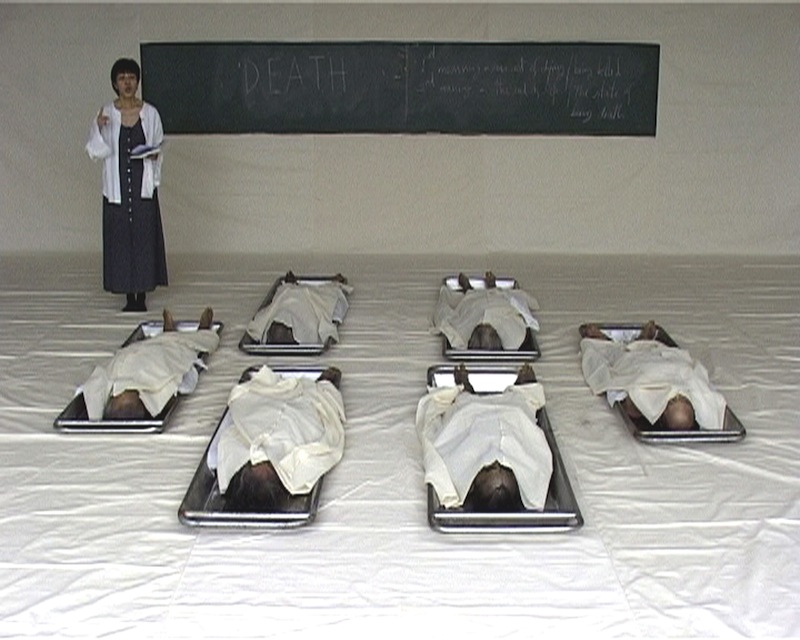
© » KADIST
Araya Rasdjarmrearnsook
The Class (2005) by Araya Rasdjarmrearnsook challenges the viewer’s personal sense of morality and tolerance by depicting a classroom from hell. In the video, a woman, dressed in black with a white over shirt, stands in front of a long blackboard. The classroom’s rear walls and floor are covered in taut white fabric, given the room the sinister appearance of a sanitarium or a crime scene.

© » KADIST
Elizabeth McAlpine
Elizabeth McAlpine’s work frequently deals with time based issues as well as the experience of watching. In The Height of the Campanile , McAlpine has calculated the height of the tower and timed her shooting of it so that the length of the film in meters is exactly that of the height of the tower. Thus the time it takes to view the film, and the pace at which the camera pans up the tower are equivalent to the height of the tower.

© » KADIST
Maria Bussman
Drawing & Print (Drawing & Print)
The drawing “Heidegger’s Cabin” (2005) is inspired by Martin Heidegger’s essay, “The Origin of the Work of Art.” During the artist’s stay in a high alpine area, near a lake reservoir, Bussmann related the landscape in her surroundings to her reading of Heidegger’s terms on the work of art and the meaning of a “thing.” In attempt to link spiritual heights to natural heights, Bussmann metaphorically relates the subjects of being and truth to a hiking path, and its different degrees of challenge and risk. In the drawings rather than finding the optimal path to reach ultimate meaning and materialization, Bussmann never arrives at “Heidegger’s Cabin,” and instead is led off the beaten track to areas she never discovered before. Upon her return from the mountains in 2004 and 2005, she continued to develop the series, leading up to 20 drawings on handmade paper that attempt to problematize Heidegger’s theory on artworks as “things” as bearers of traits, “things” confronting the world of perception, and “things” as formed matter.

© » KADIST
Carla Zaccagnini
This series of photographs, Sobre la igualdad y las diferencias: casas gemelas (On Equality and Differences: Twin Houses) , taken in Havana in 2005, belongs to a wider group of works that the artist has been developing over many years, generally titled Bifurcaciones y encrucijadas (Forking Paths and Crossroads) . These works are dedicated to the collection and investigation of similarities and singularities. Some focus on things that are supposed or expected to be identical, but end up being slightly different.

© » KADIST
James Welling
#17 Pink is a photogram, a photographic image produced without the use of a camera. Here, the artist placed plumbago blossoms on a sheet of eight-by-ten-inch film and exposed it to light. The negative was then projected onto Kodak Metallic Endura paper through a color mural enlarger and cooler filters to produce the multicolored print.

© » KADIST
Richard Gordon
Washington D. C. Constitution Ave. is a silver gelatin print from the series American Surveillance , a ten-year-long project where Richard Gordon photographed surveillance cameras across USA. In the image, a woman and a child walk along Constitutional Avenue as a surveillance camera on the street post directs its gaze towards them. The otherwise quiet image then becomes an exercise of resistance: together with the other images from the series, Gordon’s photograph documents the changes that have taken place in architecture, civic life, especially in a post 9/11 experience of public space.

© » KADIST
Toby Ziegler
The Fifth Quarter might have taken its mysterious inspiration from the eponymous Stephen King story collated into the Nightmares & Dreamscapes collection. Various vanishing points and interior perspectives, like in another painting dated the same year called Continental Breakfast , create a complex matrix in which motifs, shadowy or geometric forms coexist to further confuse the map of this space. A disturbing yet alluring virtual reality composed of a medley of seemingly abstract designs is depicted through digital and painterly means.
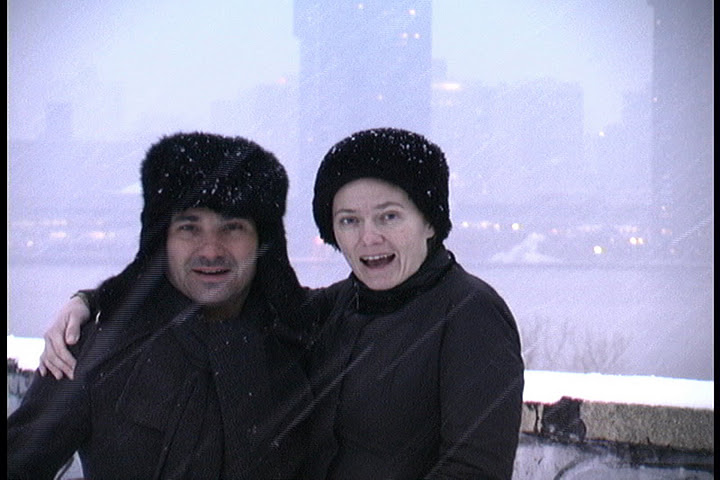
© » KADIST
Leonardogillesfleur
Leonardogillesfleur describe Action 3:02 as their “first New York blizzard storm at about 5am. The photographic moment of a photo album which could have been taken by anybody in any familiar situation with the intention to immortalize that moment.”

© » KADIST
Pedro Reyes
In Reyes’s words, “We should be able to extract the technological nutrients before we excrete our waste. There is a missing organ in our social metabolism which would work as a stomach or intestines. The Recyclone is a device made of plastic containers that fit into each other.

© » KADIST
Rudolf Polanszky
Polanszky’s sculpture is made from raw, found materials that have the patina of age. He brings together disparate material discarded by society to form aggregates. Although it is not his intention to make works of meaning the viewer endows them with poetic meanings and constructs.
Shooshie Sulaiman
Shooshie Sulaiman is one of the leading creative practitioners in Southeast Asia...
Alexandre da Cunha
- location: London, United Kingdom
- year born: 1969
- gender: male
- nationality: Brazilian
- home town: Rio de Janeiro, Brazil
Raymond Pettibon
- location: Hermosa Beach, California
- year born: 1957
- gender: male
- nationality: American
- home town: Tucson, Arizona
Leonardogillesfleur
The artistic entity “leonardogillesfleur” is the alliance between two artists, Leonardo Giacomuzzo (b...
Michael Craig-Martin
Michael Craig-Martin studied fine art at Yale University returning to Europe in the mid-1960s and becoming one of the key figures in the first generation of British conceptual artists...
Jennifer Locke
Working in video and installation-based performance, Jennifer Locke stages physically intense actions in relation to the camera and specific architecture in order to explore the unstable nature of artist/model/camera/audience hierarchies...
Mario Garcia Torres
- location: Mexico City, Mexico
- year born: 1975
- gender: male
- nationality: Mexican
- home town: Monclova, Mexico
Pablo Pijnappel
Pablo Pijnappel’s work is foremost highly constructed...
Chloe Piene
- year born: 1972
- gender: female
- nationality: American
- home town: Stamford, Connecticut
Maria Bussman
Maria Bussmann’s works represent an insistent attempt to fathom the epistemological quality of her medium, drawing...
Kara Walker
- location: New York, New York
- year born: 1969
- gender: female
- nationality: American
- home town: Stockton, California
Gregory Crewdson
- location: New York, New York
- year born: 1962
- gender: male
- nationality: American
- home town: Brooklyn, New York
James Welling
- location: New York, New York; Los Angeles, California
- year born: 1951
- gender: male
- nationality: American
- home town: Hartford, Connecticut
David Haxton
Although trained as a painter, David Haxton is known for his exploration of light through the mediums of photography and film...
Rudolf Polanszky
Rudolf Polanszky, who has been working since the 1980s, is a Viennese artist...
Richard Gordon
Originally from Chicago, Richard Gordon was a self-taught photographer best known for his intelligent and masterfully printed black-and-white photographs...
Harrell Fletcher
- location: Portland, Oregon
- year born: 1967
- gender: male
- nationality: American
- home town: Santa Maria, California
Amie Siegel
- year born: 1974
- gender: female
- nationality: American
- home town: Chicago, Illinois
Elizabeth McAlpine
Elizabeth McAlpine has described herself as a « fanatical geologist » who explores the different layers of cinematic footage...
Abraham Cruzvillegas
- location: Mexico
- year born: 1968
- gender: male
- nationality: Mexican
- home town: Mexico City, Mexico
Nagendra Gurung
Since the mid-2000s, Nagendra Gurung has practiced photography in parallel to his life as a migrant worker in Dubai and Saudi Arabia...
Pedro Reyes
- location: Mexico City, Mexico
- year born: 1972
- gender: male
- nationality: Mexican
- home town: Mexico City, Mexico
Michal Chelbin
Michal Chelbin was born in 1974 in Israel...
David Maljkovic
- location: Rijeka, Hrvatska
- year born: 1973
- gender: male
- nationality: Croatian
Toby Ziegler
- location: London, United Kingdom
- year born: 1972
- gender: male
- nationality: British
Todd Hido
- location: San Francisco, California
- year born: 1968
- gender: male
- nationality: American
- home town: Kent, Ohio
Minouk Lim
- location: Seoul, South Korea
- year born: 1968
- gender: female
- nationality: Korean
Juan Capistran
- location: Los Angeles, California
- gender: male
- nationality: Mexican American
- home town: Guadalajara, Mexico
Cerith Wyn Evans
- location: London, United Kingdom
- year born: 1958
- gender: male
- nationality: British
- home town: Llanelli, United Kingdom
Carla Zaccagnini
- year born: 1973
- gender: female
- nationality: Brazilian
- home town: Buenos Aires, Argentina

